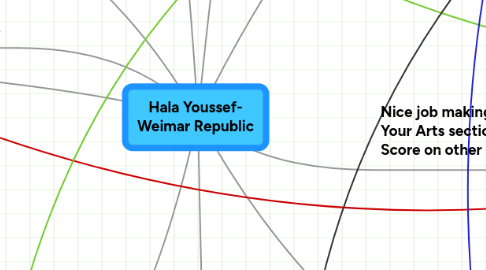
1. Economics
1.1. Attempts at economic recovery
1.1.1. Loans from the USA
1.1.1.1. German version of the Roaring '20s
1.1.1.2. Increase in value of Reichsmark against dollar
1.1.1.2.1. July 1914- 4.2
1.1.1.2.2. Nov 15, 1923- 4,200,000,000,000
1.1.1.3. Improved relations with the US
1.1.2. Matthias Erzberger's plans
1.1.3. Control of unemployment
1.1.4. Welfare legislation of 1927
1.1.5. Increase in industrial output
1.1.5.1. At pre-war levels by 1923
1.1.5.2. Double of pre-war levels by 1929
1.2. Reparations
1.3. New node
1.4. Changes to the economy
1.4.1. Currency
1.4.2. Currency backing
1.4.2.1. Agricultural resources
1.4.2.2. Industrial Resources
1.5. Occupation of Ruhr
1.6. Inflation
1.6.1. Blame on Republic
1.6.2. Began under Kaiser
2. Arts
2.1. More, better art
2.1.1. Specialism
2.1.2. 'New Objectivity'
2.1.3. German expressionism
2.1.3.1. Nolde
2.1.3.2. Kandinsky
2.1.3.3. Kirchner
2.1.4. Dada
2.1.4.1. John Harfield
2.1.4.2. Hannah Hoch
2.1.4.3. George Grosz
2.1.4.4. Otto Dix
2.2. Boom in German Film industry
2.2.1. Absence of foreign films
2.2.2. Leni Reifenstahl
2.2.3. Mountain films
2.2.4. Two main genres
2.2.4.1. Fantastic and mystical
2.2.4.2. Realistic and psychological
2.3. More musical diversity
2.3.1. Arrival of Jazz to Germany
2.3.2. 3 Penny Opera
2.4. Prosper of literature
2.5. Change in architecture style
2.5.1. Bauhaus
3. Technology
3.1. Radio
3.2. Campaigns
3.3. Scientific discovery
3.3.1. Effect of cigarettes
3.4. Cinema and film making
3.5. Training in Russia
4. People/ Events
4.1. New constitution in 1919
4.2. Politicians
4.2.1. Stressmann
4.2.2. Hindenburg
4.2.3. Hitler
4.3. See politics and other mindmap
5. I put the score on your other map. Keep up the good work.
6. Social
6.1. Resentment about foundation of the Republic
6.1.1. Burden of increased taxes
6.2. Camps of Youth and Soldiers
6.3. Prejudice against Socialists and Jews
6.4. The 'Golden Age
6.4.1. More jobs because of increased productivity
6.4.2. Cafe/ club culture
6.4.3. More appreciation of the arts
6.4.4. Flourishing sciences
6.5. Effects of Inflation
6.5.1. Loss of pensions
6.5.2. Labor Unions
6.5.3. Impossibility of traditional German wedding/ marriage
6.5.4. Loss of life savings (because of currecy drop)
6.6. Temporary understanding between armed forces and Republic
6.7. German Volk
6.7.1. Importance of national identity
6.8. Education
6.8.1. Compulsory primary school
6.8.1.1. Public School
6.8.1.2. Private School
6.8.2. Improvement of Universities
7. Political
7.1. Weimar Republic as successor of the Reich
7.1.1. National Assembly
7.1.2. Constitution
7.1.3. Policy of Fulfillment
7.2. Political parties
7.2.1. Social Democratic Party
7.2.2. Communist Party (KPD)
7.2.3. Democratic Party (DDP)
7.2.4. Left vs. Right
7.2.4.1. Left
7.2.4.1.1. KPF
7.2.4.1.2. General hostility between Left and Social Democrats
7.2.4.2. Right
7.2.4.2.1. Nationalists (DNVP)
7.2.4.2.2. NSDAP (Nazis)
7.2.4.2.3. Violent expression of national hostility
7.2.4.2.4. Hostility towards frivolity of the Golden Twenties
7.2.5. Center Party
7.3. Basis on bitterness and resentment
7.3.1. Denial of German entrance into the League of Nations
7.3.2. Territorial losses
7.3.2.1. Alsace-Lorraine to France
7.3.2.2. West Prussia and Posen (Polish Corridor) to Poland
7.3.2.3. Losses after Plebiscites
7.3.2.3.1. Eupen and Malmedy to Belgium
7.3.2.3.2. Northern Schleswig to Denmark
7.3.2.3.3. Part of Upper Silesia to Poland
7.3.2.3.4. Danzig as a free city
7.3.2.3.5. Memel
7.3.2.3.6. Saarland
7.3.3. Reparations and loss of fruit of German production to foreign nations
7.3.4. Claims that defeat was caused by betrayal of secret enemy at home
7.4. Obstacles
7.4.1. Threats from Left
7.4.1.1. Sparcist Rising
7.4.1.2. Communist Rising in Ruhr
7.4.2. Threats from Right
7.4.2.1. Kapp Putsch
7.4.2.2. White Terror
7.4.2.3. "Beerhall Putsch"
7.4.3. Collapse of coalitions
7.4.4. Parties' unwillingness to compromise
7.4.4.1. Extremists' gain of power
7.5. Stable political leadership
7.5.1. Gustav Stressmann (1923)
7.5.1.1. Reduced reparations payments
7.5.1.1.1. Dawes Plan
7.5.1.1.2. Locarno Pacts
7.5.1.2. Orthodox conservative
7.5.1.3. Positions
7.5.1.3.1. Chancellor (for 3 months)
7.5.1.3.2. Foreign Minister till death in 1929
7.5.2. Paul von Hinderburg
7.5.2.1. Man of impeccable patriotic credentials
7.5.2.1.1. Wartime hero
7.5.2.1.2. Election based on nostalgia
7.5.2.2. Effectively defended the Republic
7.6. Loss of power
7.6.1. Rise of Nazism (see other mindmap)
7.6.2. Appointment of Hitler as Chancellor
8. Religion
8.1. Freedom of belief and conscience
8.2. Religious population
8.2.1. 65% Protestant
8.2.1.1. Lutheran
8.2.1.2. Reformed
8.2.2. 34% Catholic
8.2.3. 1% Jewish
